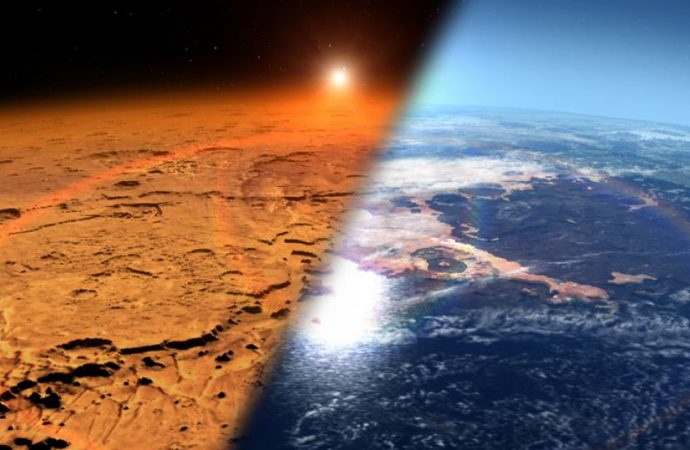Dust storms triggered the loss of massive amounts of water from high in Mars’ atmosphere, according to new analysis of data collected by NASA’s MAVEN spacecraft. For the first time, water has been tracked all the way into Mars’ upper atmosphere, say the authors of a new paper appearing in the journal Science.
Source: Forbes
Data from the Mars Atmosphere and Volatile Evolution (MAVEN) mission show that the water abundance at these altitudes goes up dramatically when there’s a dust storm – the dust allows the water to be carried to higher altitudes, Bruce Jakosky, MAVEN’S Principal Investigator and a planetary scientist at the University of Colorado in Boulder, told me.
The greater water abundance at these altitudes leads directly to a greater Hydrogen escape rate, says Jakosky. It’s possible that a large part of the hydrogen escape to space occurs during the dust storms that occur every few years, rather than spread throughout the year, he says.
“Understanding Hydrogen loss is key to sorting out the history of water on Mars, so this is a significant new result,” said Jakosky.
Water only has a lifetime of about four hours in mars’ upper atmosphere, which means it is destroyed about 10 times faster in the upper atmosphere than if it stopped in the middle atmosphere, Shane Stone, a planetary scientist at the University of Arizona’s Lunar and Planetary Laboratory and the paper’s lead author, told me.
Stone and his team linked this newfound water outflux mechanism to seasonal variations in Mars’ atmosphere. Mars is at its warmest when it is closest to the Sun during summer in its southern hemisphere, he says. That’s when these regional and global dust storms occur. During such periods, the hygropause (a cold layer in the atmosphere at which water condenses from a vapor to a liquid, producing clouds) is warmed and weakened. This, in turn, allows water into the upper atmosphere.
During such warm periods, water ice in Mars’ polar caps is converted from ice to vapor, says Stone. Water is subsequently transported upward past a weak hygropause and into the upper atmosphere, he says. Once there, it’s disassociated into its constituent hydrogen and oxygen atoms.
These measurements show that H2O vapor is carried to higher altitudes than had been previously thought – up to as high as the MAVEN spacecraft, around 150 or so km in altitude, says Jakosky. From there, it’s much easier to break the H2O apart and then for Hydrogen to escape into space, he says.
The team estimates that this high-speed upper atmospheric water loss has likely been an ongoing process for at least a billion years. And just over the last billion years, Mars’ might have lost as much as a global body of water some 17 inches deep due to this process.
Over its 4.5 billion-year history, however, the authors estimate that Mars has likely lost enough water to cover the planet’s surface with an ocean tens to hundreds of meters deep, and that H2O loss rates must have been even higher in the past.
We still do not know exactly when this mechanism began to operate, says Stone. The extrapolation of atmospheric escape rates back in time to more than 4.5 billion years ago was already an incredibly difficult thing to do, he says. “This new mechanism only makes that calculation more difficult,” said Stone.
Source: Forbes

































Leave a Comment
You must be logged in to post a comment.